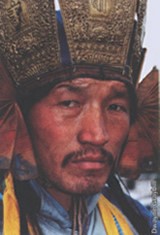Nearly three centuries ago the Monba people migrated across the Himalayas from the Moinyu area to southeast Tibet. Numerous Monba speakers today still live within the borders of India. Until 1959 the Monba were oppressed serfs of the Tibetans. They had to ask permission from the Tibetans just to make a journey.
The Monba are one of China's officially recognized nationalities. Cona Monba is "quite distinct linguistically" from Medog Monba. The speakers of the two Monba languages, which are part of the Eastern Himalayan branch of Tibeto-Burman, struggle to communicate with each other. The two groups must use Tibetan as a common language. Cona Monba has four tones, while Medog Monba does not contain any tones at all.
Cona Monba, which is known as Tsangla in Bhutan and India, live in the southern part of Tibet, particularly in Cona County. Others are scattered far to the northeast in Medog County. The majority of the speakers of this language live in eastern Bhutan. Approximately 44,000 also inhabit the Kameng District in Arunachal Pradesh, India.
The Monba are the only minority group in China to practice "river burial," by which a corpse is cut into 108 pieces and hurled into a rushing river to be washed away. The Tibetans consider this to be the lowest form of burial and only use it for children and lepers. Some Monba practice Tibetan bird burials. The number 20 is the basic counting unit of the Monba. Thus, 67 becomes three twenties plus seven, and so on. Monba silversmiths are renowned for their skill in making intricate jewelry and ornaments.
Although most Monba are outwardly Tibetan Buddhists, the majority continue to practice numerous shamanistic and polytheistic rituals. The Monba believe all disease is caused by demons. They feel they are forced to sacrifice their valuable cattle and horses in order to pacify these angry demons and cause the affliction to cease. They also believe humans can be demons who cause sickness. A boy or girl who marries into a "demon family" too becomes a demon. Therefore "demon families" are allowed to intermarry only.
The Monba are one of the most unreached and inaccessible people groups in all of China. They have no knowledge of the gospel. Few Christians have ever prayed for them. Foreigners are not permitted to enter their region from either the Tibetan or the southern side of the border. There are currently shortwave gospel radio broadcasts in the Tsangla language of Bhutan which perhaps can be heard and understood by the Cona Monba. In 1996 several Bhutanese Christians crossed into Tibet for the purpose of evangelism.
Without the guidance of Christ, these people are like sheep without a shepherd. They need the good shepherd in their families and communities.
Pray for the spiritual blindness and bondage to the evil one to be removed so they can understand and respond to Christ.
Pray for the Lord to provide for their physical and spiritual needs as a testimony of his power and love.
Pray that the Cona Monba people will have a spiritual hunger that will open their hearts to the King of kings.
Pray for an unstoppable movement to Christ among them.
Scripture Prayers for the Monba, Cona in China.
Operation China, Asia Harvest, Copyrighted © Used with permission
| Profile Source: Joshua Project |











